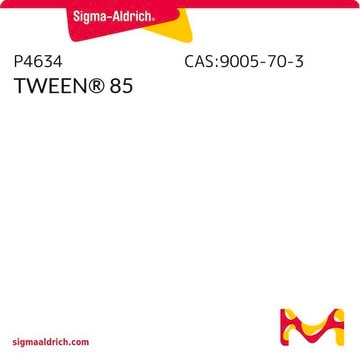P1754
TWEEN® 80
viscous liquid
Sinónimos:
Monooleato de POE (20) sorbitano, Monooleato de polietilenglicol sorbitano, Monooleato de polioxietilen sorbitano, Polisorbato 80
About This Item
Productos recomendados
biological source
Porcine (tallow)
bovine (tallow)
Quality Level
description
non-ionic
form
viscous liquid
mol wt
micellar avg mol wt 79,000
average mol wt 1310
composition
Oleic acid, ≥58.0% (balance primarily linoleic, palmitic, and stearic acids)
aggregation number
60
CMC
0.012 mM (20-25°C)
viscosity
400-620 mPa.s
transition temp
cloud point 65 °C
solubility
water: soluble, clear to slightly hazy, colorless to yellow
density
1.064 g/cm3
HLB
15
application(s)
cell analysis
SMILES string
CCCCCCCC/C=C/CCCCCCCC(=O)OCCOCC(C1C(CC(O1)OCCO)OCCO)OCCO
InChI
1S/C32H60O10/c1-2-3-4-5-6-7-8-9-10-11-12-13-14-15-16-17-30(36)40-25-24-37-27-29(39-22-19-34)32-28(38-21-18-33)26-31(42-32)41-23-20-35/h9-10,28-29,31-35H,2-8,11-27H2,1H3/b10-9+
InChI key
RGPBUVUVZKQNHD-MDZDMXLPSA-N
¿Está buscando productos similares? Visita Guía de comparación de productos
General description
application
Biochem/physiol Actions
Features and Benefits
- Excellent wetting and dispersing agent
- Highly versatile surfactant for your Cell Biology and Biochemical research
Other Notes
Legal Information
comparable product
Storage Class
10 - Combustible liquids
wgk_germany
WGK 1
flash_point_f
>235.4 °F - closed cup
flash_point_c
> 113 °C - closed cup
ppe
Eyeshields, Gloves
Choose from one of the most recent versions:
¿Ya tiene este producto?
Encuentre la documentación para los productos que ha comprado recientemente en la Biblioteca de documentos.
Los clientes también vieron
Nuestro equipo de científicos tiene experiencia en todas las áreas de investigación: Ciencias de la vida, Ciencia de los materiales, Síntesis química, Cromatografía, Analítica y muchas otras.
Póngase en contacto con el Servicio técnico






